
Aloeides dentatis, the Roodepoort copper, is a species of butterfly in the family Lycaenidae. It is found in Lesotho and South Africa.

Spialia sertorius, commonly known as the red-underwing skipper, is a butterfly of the family Hesperiidae.
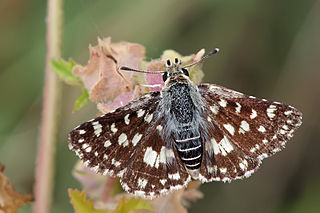
Spialia is a genus of skippers in the family Hesperiidae, which are mainly found in Africa and Asia. They are commonly called grizzled skippers or sandmen.
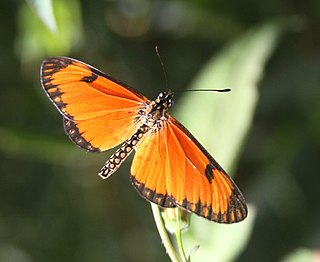
Acraea eponina, the orange acraea or small orange acraea to distinguish it from the larger A. anacreon, is a butterfly of the family Nymphalidae. It is found in tropical Africa and south-western Arabia.

Eretis djaelaelae, commonly known as the marbled elf, is a species of butterfly in the family Hesperiidae. It is found from Somalia southwards to South Africa. The habitat consists of savanna woodland and sometimes also grassland. Similar to Eretis umbra but has white forelegs.

Netrobalane canopus, the buff-tipped skipper, is a butterfly of the family Hesperiidae. It is found in savannah in Africa, from South Africa to Kenya to Nigeria and southern Sudan.

Spialia nanus, the dwarf sandman, is a butterfly of the family Hesperiidae. It is found in South Africa, in the western Cape, western Free State, southern North West Province and the northern Cape.
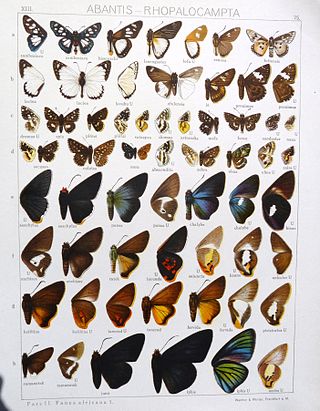
Spialia sataspes, the Boland sandman, is a butterfly of the family Hesperiidae. It is found in South Africa, in fynbos in the western Cape and along the mountain chains of the northern Cape and along the coast to Port Elizabeth in the eastern Cape and inland to Bedford and Grahamstown.
Spialia depauperata, the wandering sandman or deprived grizzled skipper, is a butterfly of the family Hesperiidae. It is found from Kenya to Natal and in Uganda.
Spialia asterodia, the star sandman or Asterodia sandman, is a butterfly of the family Hesperiidae. It is found in South Africa from the western Cape to the southern part of the north Cape and across the east Cape to Lesotho, the Free State, Eswatini, western KwaZulu-Natal, Mpumalanga, the Limpopo Province, the eastern North West Province and Gauteng. It is also present in southern Mozambique and Zimbabwe. The habitat consists of grassland and grassy areas in fynbos, Karoo and Bushveld.
Spialia agylla, the grassveld sandman, is a butterfly of the family Hesperiidae. It is found in South Africa.

Spialia secessus, the Wolkberg sandman, is a butterfly of the family Hesperiidae. It is found in high savannah and montane grasslands from Eswatini to northern KwaZulu-Natal, the eastern part of the Limpopo Province and Mpumalanga. It is also present in Zimbabwe. It is named after the Wolkberg range.
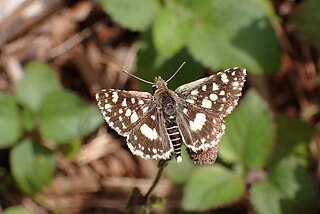
Spialia dromus, the forest sandman, dromus grizzled skipper or large grizzled skipper, is a butterfly of the family Hesperiidae. It is found in tropical Africa. In South Africa it is found along the eastern Cape coast to KwaZulu-Natal into Eswatini. It is also present in Mpumalanga and the Limpopo Province into northern Gauteng and the extreme north-west of the North West Province.

Spialia spio, the mountain sandman or Spio grizzled skipper, is a butterfly of the family Hesperiidae. It is found in tropical Africa and south-western Arabia. It is found in eastern South Africa.

Spialia colotes, the Bushveld sandman, is a butterfly of the family Hesperiidae. The species was first described by Herbert Druce in 1875. It is found in Angola, Botswana and from South Africa to Ethiopia and south-western Arabia.
Spialia confusa, the confusing sandman, is a butterfly of the family Hesperiidae. It is found in south-eastern Africa, from Zululand, Zimbabwe and Mozambique to Kenya.

Spialia mafa, the Mafa grizzled skipper or Mafa sandman, is a butterfly of the family Hesperiidae. It is found in south-western Africa, in KwaZulu-Natal, Botswana, Zimbabwe and from the Cape in South Africa to Sudan and southern Arabia.

Gegenes niso, the common Hottentot skipper or plain Hottentot skipper, is a butterfly of the family Hesperiidae. It is found in Africa. It is found in a wide range of habitats, including savanna, grassland and open patches in forests.
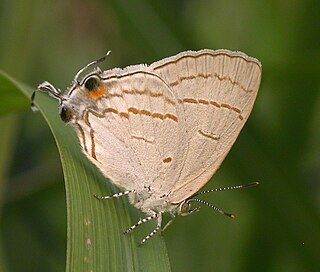
Hypolycaena philippus, the purple-brown hairstreak or common hairstreak, is a butterfly of the family Lycaenidae. It is native to sub-Saharan Africa where it is commonly found in wooded locations.













